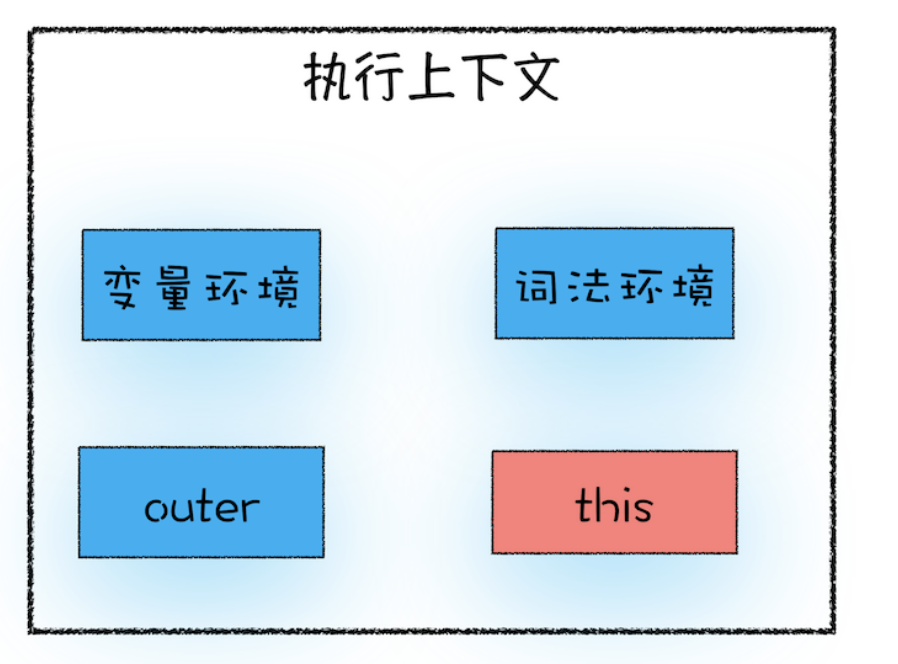This:从 JS 执行上下文视角讲 This
前面我们已经知道 JavaScript 语言的 作用域链 是由 词法作用域 决定的,而 词法作用域 是由 代码结构 来确定的。
但是如何在 对象内部 使用 对象内部的变量 呢?比如上一节例子中的 myName
var bar = {
myName: 'lafen',
getName: function() {
console.log(myName) // 期望拿到的是 lafen
}
}
console.log(bar.getName())这时, js 又搞出了一套 this 机制来支持这个需求。即添加 this 去访问即可
getName: function() {
console.log(this.myName)
}此时,你应该要注意区分,作用域链 和 this 是两套不同的系统,两者没有太大的联系。
this 是什么
关于 this , 还得从 执行上下文 说起,执行上下文中,其实还包含了 this , 执行上下文中 应包含
- 变量环境
- 词法环境
outer- this

this 是和 执行上下文 绑定的,也就是说每一个执行上下文中,都有一个 this 。即有如下 3 种执行上下文 和 this 的对应关系
- 全局执行上下文 - 全局
this - 函数执行上下文 - 函数
this eval执行上下文 -eval的this
全局执行上下文中的 this
众所周知 , 全局 this 指向的是 window 对象
函数执行上下文中的 this
先看下函数中的 this 是谁
function foo(){
console.log(this) // window
}
foo()说明普通函数调用时,函数内的 this 也是指向 window , 如果想更改,可以使用以下方式
通过 call 修改 this 指向
观察以下代码,尝试打印试试
let bar = {
myName : "极客邦",
test1 : 1
}
function foo(){
this.myName = "极客时间"
}
foo.call(bar)
console.log(bar)
console.log(myName)foo函数通过call来调用,并传入了bar对象,改变了foo函数内部的this指向bar- 打印
bar发现其中的bar.myName已经被修改
此外还有 apply 和 bind 也是修改可以修改 this 指向的方法。
通过对象调用方法设置
var myObj = {
name : "极客时间",
showThis: function(){
console.log(this)
}
}
// 通过对象调用方法, this 指向对象
myObj.showThis()但注意区别以下代码,全局中调用函数, this 指向又会变成 window
var myObj = {
name : "极客时间",
showThis: function(){
console.log(this)
}
}
const show = myObj.showThis
show() // this 指向 window通过构造函数设置
function CreateObj(){
this.name = "极客时间"
}
var myObj = new CreateObj()new 一个对象时,可以看作 js 引擎处理如下
- 首先创建了一个空对象
tempObj - 接着调用
CreateObj.call方法,并将tempObj作为call方法的参数,这样当CreateObj的执行上下文创建时,它的this就指向了tempObj对象 - 然后执行
CreateObj函数,此时的CreateObj函数执行上下文中的this指向了tempObj对象 - 最后返回
tempObj对象
此时,构造函数中的 this 指向的是新创建出来的实例对象
this 缺陷
js 中的 this 实际上非常反直觉
嵌套函数中的 this 不会从外层函数中继承
看以下代码
var myObj = {
name : "极客时间",
showThis: function() {
console.log(this)
function bar() {
console.log(this)
}
bar()
}
}
myObj.showThis()按直觉来说, bar() 函数中的 this 应该和 showThis() 函数中的 this 一致,都指向 myObj 才对,但是实际上却是
showThis()中指向的是myObjbar()中指向的是window
想解决上面 bar() 中的 this 的反直觉指向问题,可以通过保存一下 this 来解决,本质上是将 this 体系,转换成 作用域 体系
var myObj = {
name : "极客时间",
showThis: function() {
console.log(this)
var self = this
function bar() {
self.name = "极客邦"
}
bar()
}
}
myObj.showThis()
console.log(myObj.name)
console.log(window.name)或者,使用 es6 的箭头函数来解决
var myObj = {
name : "极客时间",
showThis: function(){
console.log(this)
var bar = () => {
this.name = "极客邦"
console.log(this)
}
bar()
}
}
myObj.showThis()
console.log(myObj.name)
console.log(window.name)这是因为 ES6 中的 箭头函数 并不会 创建其自身的 执行上下文 ,所以 箭头函数 中的 this 取决于它的 外部非箭头函数。
所以,解决 嵌套函数中的 this 不会从外层函数中继承 的问题,我们有两种方式
- 第一种是把
this保存为一个self变量,再利用变量的作用域机制传递给嵌套函数 - 第二种是继续使用
this,但是要把嵌套函数改为 箭头函数 ,因为箭头函数 没有 自己的 执行上下文 ,所以它会继承调用函数中的this
普通函数中的 this 默认指向全局对象 window
实际工作中,我们并不希望函数执行上下文中的 this 默认指向 全局对象 ,因为这样会打破数据的边界,造成一些误操作。
如果要让函数执行上下文中的 this 指向某个对象,最好的方式是通过 call 、 apply 、 bind 方法来显示调用。
这个问题也可以通过设置 JavaScript 的 严格模式 来解决。在严格模式下,默认执行一个函数,其函数的执行上下文中的 this 值是 undefined ,这就解决上面的问题了。
总结
- 构造函数的
this指向new创建的新对象 - 通过对象调用方法,
this指向该对象 - 函数正常调用时,严格模式下
this指向undefined, 非严格模式下this指向window - 嵌套函数中的
this不会继承外层函数的this - 箭头函数没有自己的执行上下文,所以箭头函数的
this就是它外层非箭头函数的this